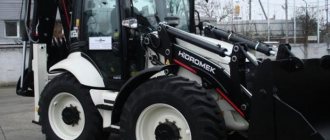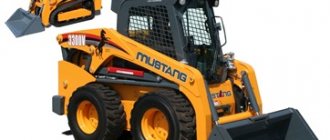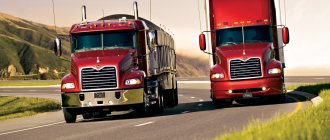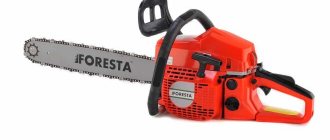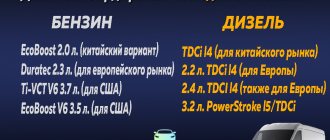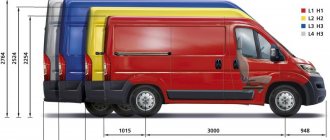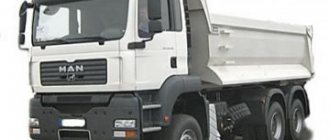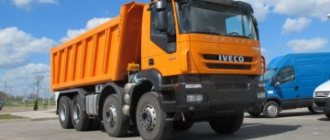Assimilated French
Pavel Gamankov, photo by the author
Renault Kerax 6x4 dump trucks are already being assembled at a plant in Kaluga, and they will soon go on wide sale in Russia. When these cars appear on dealer sites, we will definitely take a domestic-made car for testing. In the meantime, as a starting point with which we will subsequently compare Kaluga-assembled Renault dump trucks, our test included a fresh thoroughbred “European” from 2010 – the Renault Kerax 380.34 6×4 HD.
It is not so easy to determine that this is a purebred French dump truck. The attentive reader can be misled not only by the dashing Russian Khokhloma patterns on the cabin, but also by less noticeable details of the modification of the car for use in Russia. In particular, the protective “arches” of the rear bogie are made of stainless metal; additional aluminum shields cover the battery box and fuel tank. The vehicle is equipped with a reinforced 16 cc Feber dump body made in Poland. The body with rear unloading and front-mounted hydraulic cylinder is equipped with a system for heating the sides with exhaust gases.
The installed cabin is called Global in Renault language, but in common parlance it is more like a “lorry”. That is, there is no sleeping place inside, but there is enough free space behind the passenger and driver seats. External features include protective grilles on both the headlights and rear lights. This is an important part for a dump truck. Another issue is that the front grilles are made as a single block and do not open, so it is difficult to clean the optics from dirt and snow. A three-section steel bumper is also quite appropriate for a dump truck. Firstly, it will not be so easily damaged, and secondly, replacing one of the parts of the bumper will not put a big dent in the owner’s pocket. And the last tipper feature is that the air intake pipeline is located almost at the level of the truck roof, which means that when working on dusty construction sites or in quarries, the dump truck will “swallow” less dust.
The battery box and fuel tank are covered with additional shields
Characteristics
Since 2009, Kerax has been equipped with a 6-cylinder diesel engine DXi11 with a capacity of 11.1 liters.[4] which is Euro 5 compliant, available in three tune states: 380 hp. (283 kW; 385 hp) / 1,800 N⋅m (1,328 lb⋅ft), 430 hp (321 kW; 436 PS) / 2,040 N⋅m (1,505 lb⋅ft) and 460 PS (343 kW; 466 hp) / 2,200 N⋅m (1,623 lb⋅ft). There is a choice of a 16-speed manual transmission and a 12-speed automatic transmission.
Until 2009, the Kerax was equipped with Euro 3 DXi11 10.8 liter engines producing 330 hp. (246 kW; 335 hp) / 1,650 N⋅m (1,217 lb⋅ft), 380 hp (283 kW; 385 PS) / 1,850 N⋅m (1,364 lb⋅ft) and 440 PS 328 kW; 446 hp) / 2,000 N⋅m (1,475 lb⋅ft).
The suspension varies depending on the model; parabolic on the 26t version and semi-elliptical on the 32t version. Three cab options are available, all 2,300 mm (90.6 in) wide and 1,600 mm (63.0 in) to 2,200 mm (86.6 in) long. The wheelbase can vary from 3,200 mm (126.0 in) to 6,000 mm (236.2 in).
Kerax is produced in the Russian city of Kaluga at the Volvo Trucks plant, which opened in 2009.[5]
Rich and modest
The Renault Kerax 380.34 6×4 HD dump truck has rich internal equipment, and, looking ahead, we can say that the overall impression of driving the truck was positive. But it was only when I got into the Frenchman’s cabin and took the driver’s seat that I was completely struck by one small detail. The 2010 French car has a non-adjustable steering column. Neither in terms of inclination nor in reach! Of course, this is far from the most important detail of the “aircraft”, but for a modern European truck it is, at least, strange. But the air-suspended seat with a headrest and tangible lateral support has a huge range of adjustments. Thanks to the large cabin and the absence of a “sleeping bag,” when parked, you can move significantly back and even sit more or less comfortably with your legs stretched forward. When driving a dump truck, the seat allows you to select a convenient landing algorithm and adjust the height and stiffness of the air suspension.
Unlike most modern European trucks, the Renault cabin has a high engine tunnel that divides the interior space into two zones. It makes it uncomfortable when parked, but the truck is comfortable to drive. The passenger door control keys are duplicated on the left of the driver, so opening the window or locking the right door is not difficult. The pilot does not have to jump from one part of the cabin to another; the gearbox lever is located on the engine tunnel and fits comfortably in the hand, while the driver’s movements are not constrained by the cockpit frame. The high seating position and large glass area provide good visibility from the driver's seat. But there are no rear cabin windows for better thermal insulation. The noise level in the cabin is also worthy of a positive review. Vibrations of the power unit are practically not transmitted to the controls, and when driving at high speeds the driver is not bothered by aerodynamic noise.
The truck's multi-steering wheel turned out to be convenient and suitable for frequent use. Navigation of the Russified on-board computer is clear and does not cause difficulties. In addition, using the buttons on the steering wheel you can control the standard audio radio, engine retarder, cruise control, etc.
The instrument cluster looks different from the usual one. Instead of a round speedometer with arrows, the Renault Kerax dump truck has an LCD display with a digital indication of the truck's speed. This solution is unusual for the eye, but the instrument readings are readable. Red and white tones are chosen for the illumination; the brightness of the instrument lighting and sound notification of the on-board computer can be adjusted at will. When braking sharply and the ABS system is activated, the electronics automatically turns on the vehicle's hazard warning lights.
To sum up the review of the Renault Kerax 380.34 6×4 HD interior, we can say that the dump truck has only two drawbacks: a non-adjustable steering column (but this is only a matter of specific configuration; in some modifications the steering wheel is adjustable) and a high engine tunnel. In all other respects, the interior of the “Frenchman” evokes only positive emotions. Particularly impressive are the excellent sound insulation and modern electronic components with a Russified on-board computer.
Recommendations
- Truck Trader March 4, 2011
- "Renault unveils all-new EURO VI trucks." Chinatrucks.com. Retrieved June 25, 2013.
- "Classify". Renault Trucks Defense. Archived from the original on May 30, 2013. Retrieved June 25, 2013.
- Roadtransport.com
- Just-auto.com October 17, 2007
- "Canada places major military order with Mack."
- “Medium Support Vehicle System—Defense Capability Blueprint.”
- Renault Kenya website
For Russia
The Renault Kerax 380.34 6×4 HD dump truck was developed quite a long time ago and retained such archaic elements as a high engine tunnel, a massive gear lever with a cable drive instead of a modern joystick, etc. In addition, the electronic filling of the truck seemed somewhat damp to me. But all these little things do not affect the operation of the dump truck in any way. The vehicle is perfectly suited for working on bad roads (and if you quote the advertising brochure verbatim), it has a reinforced frame and body, a load capacity of almost 25 tons and is even designed to work as part of a road train. The not-so-powerful power unit has good torque, which is much more important for a dump truck. Therefore, it is not surprising that Renault chose this particular model for promotion in Russia.
I will steal you, I will steal you at night, I will take you away, I will take you to Sochi.
The wise moon will hide, Dad, mom, don’t cry, don’t cry. Do you remember such a funny song from Lapis? But that’s practically what happened to me. Of course, no one kidnapped me, but in order to get on the plane to Sochi on time, I had to get up at three in the morning.
I had never been to Sochi before, so it was, of course, interesting to see these places.
01.
Many people imagine Sochi something like this. In principle, indeed, most vacationers see it this way throughout their entire vacation.
But there is also the most interesting nature here. Below there are tropics, in the mountains there is snow. The engineering structures here, after the Olympics, are also interesting.
02.
I liked the Skybridge suspension bridge over the Akhshtyr Gorge (White Rocks) precisely as an engineering structure. According to some sources, it is the third, according to others, the second longest suspension bridge in the world. Cool stuff!
03.
These are New Cheryomushki, which is also Sochi. Adler, to be precise. But this is also part of the “Sochi agglomeration”. As engineering structures they are not at all interesting
04.
But we are here “on another issue” and the main task awaits us where tourists do not come. It's beautiful here though! Let's take a few steps forward.
05.
Wow, I absolutely adore this beauty! We are in a stone quarry, where we will get acquainted with the Renault Trucks K series construction range.
06.
Organizing tests in “charismatic” places is absolutely correct. Russian Renault Trucks was able to find a great location!
07.
In this quarry, where stone was mined for Olympic venues, everything is absolutely adult-like - the stones are sharp, the descents/ascents are steep.
08.
This is what small pebbles look like. Imagine big ones.
What machines should we study? Several different configurations of Renault K - heirs, one might say, of the legendary Kerax. Like any modern Western manufacturer, the Renault K construction family is a set of structural components with various parameters, which, by configuring each other in various ways, you can end up with a truck that takes into account many of the nuances of future operation. The cars, which are all similar in appearance, end up being noticeably different.
09.
You can choose such-and-such axles, this or that suspension, different boxes. A separate science is dump bodies. This is what they showed us.
First the theory. Renault Trucks engineers have prepared a very intelligent, concise and intelligible presentation on the components. It makes sense to show its individual pages in the original:
10.
Briefly about the frame:
11.
The exact external sign of the K series is the “evil” steel bumper. It is, as expected, composite. The headlights are barred.
12.
About the approach angle:
13.
An interesting nuance regarding ground clearance. On an axle with a two-stage main gear, the gearbox itself turns out to be smaller. Accordingly, the ground clearance is higher with the same wheel size and tire model.
14.
Axle options:
15.
For single axle suspension:
16.
Options for double parabolic bogies:
17.
On a semi-elliptical:
18.
Heavy Duty Suspension:
19.
The Optidriver robotic gearbox is the essence, Volvo’s I-Shift.
20.
There is a version of the box for complete off-road use.
These are just the main points. In fact, there are, of course, hundreds of positions.
Let's try it in action? We have several options at our disposal with wheel formulas 6x4 and 8x4. All with "robots". There are also 6x6 on “mechanics”. All with the same 440-horsepower Renault DXi13 engines, read Volvo D13.
21.
The basic starting point is a Renault R440 6x4 with a 16 cc Meiller body. Construction tires are installed here. They can withstand overload, but do not like asphalt and fast speeds. And this nuance must be taken into account. If the tipper shoulder involves highway driving, it is better to install so-called “regional” tires, as they are called at Renault Trucks.
22.
The same car, but with a Polish Wielton body. What can I say? It goes surprisingly smoothly. Not even fully loaded and with uneven surfaces. I liked steering!
23.
Option on reinforced wear-resistant narrow tires. These will wear off less and more slowly on stones, but there is an immediate difference in comfort. Shaking!
24.
What I liked most was the four-axle vehicle. Despite the same 440-horsepower engine with a much greater dead weight of the car and cargo, in my opinion, the car drove more quickly, and the smoothness was generally like that of a large yacht.
25.
In all these machines, in addition to the “robot,” there were these two inconspicuous buttons. The OFF ROAD button “tells” the transmission to engage gears at higher speeds, which is very convenient when climbing uphill. And the “manual accelerator” (key on the right), also known as “automatic traction”, is generally a gorgeous thing! At speeds up to 30 km/h, it remembers the selected engine speed. This allows you to take your foot off the gas pedal and, therefore, not touch the pedal when bouncing on uneven surfaces. In a quarry and on bumps, it is very convenient to drive a car with this function activated.
26.
There was also a manual all-wheel drive car on test. If I understand correctly, then Renault Trucks is almost the last brand in the Euro-seven from which you can still order “pure mechanics”. But I wouldn’t take a manual car, a “robot” is many times more convenient. It's like with a smartphone. Now nothing will force me to return to a push-button handset, although at first I didn’t really accept smartphones. Same with the “robot”. Once you get used to it, you won’t want to go back to “handling.”
In a separate line I would like to mention the car that did not participate in the races. It's a pity! It would be especially interesting to ride on it. 27.
This is a Renault K480 with a more powerful 480-horsepower engine, on high, narrow, heavy-duty tires with a domestic coal-carrying body Becema BCM-157 as much as 32 “cubes”.
28.
This car is equipped with the most “brutal” 38-ton 4-leaf spring parabolic suspension XTREM.
29.
Well, of course, this dump truck, among all those present, is the most aesthetically beautiful.
Respect to Russian bodybuilders!
A quick acquaintance with the construction range of Renault Trucks stirred up thoughts in my head that had been spinning for a long time. I won’t say anything fundamentally new, but... over the past 10-15 years, trucks have become SIGNIFICANTLY structurally more complex than they were before. All these automation systems are designed to make the driver's work easier, save precious fuel and generate more income for the fleet owner. But in practice, not everything is so fabulous. A serious problem is that the correct interaction with these systems is not taught in driving schools. Drivers are often put into such cars without special training. As a result, young people do not take care of their cars, they mess with the regimes, and “old people” in general often, in principle, do not want to change their “KAMAZ” habits. The result is breakdowns, and repairs are expensive. All this leads to the fact that the potential customer decides “I’d rather buy two KAMAZ trucks”...
And to work on modern Euro-dump trucks, it doesn’t hurt even an experienced driver to first learn (this, of course, is the employer’s concern) and reconsider his views on driving techniques. You need to understand why all these electronic systems are needed, how they work, why they work the way they do, and how to use them correctly. Steering is easy now, but you also need to use your head a little differently. Only then will there be a result. Customers are gradually coming to understand this, but so far slowly.
Well, in general, Renault Trucks has a very worthy product for all types of dumping tasks. In the fall, the 8x8 version should appear in Russia, then the line on the local market will be completely covered.

